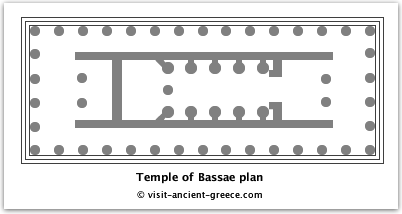
Poor Bassae! It seems to be missed out of many tours of ancient Greece. It lies south of Olympia, and is mostly visited by independent travelers. The setting doesn’t have the majestic grandeur of Delphi, or the serenity of Olympia, but is quite bleak with ravines surrounding it and wild countryside.
And for the last few years it’s been completely covered by a large tent while renovation work takes place. One of its main attractions, which has often been commented upon, is its harmony with the surroundings. In view of the fact that all you see now from outside the temple is a tent, should you make a special effort to see it?
Well of course I’m going to say yes!
Lost for centuries
For many centuries the temple at Bassae was forgotten. When europeans began to take a renewed interest in the classical world, Bassae was discovered by a french architect, Joachim Bocher, who was employed by the Venetians.
Later the internal frieze and other pieces were sold off. The British Museum bought them, and they are still there on display.
Although the temple is quite well preserved, there was a growing danger of much of it collapsing. The Greek Archaeological Society did some work on it in the early 1900’s, and then again in the 1960’s. Because of the risk of damage from the elements a special tent was placed over the whole structure in 1987. It was described as a ‘temporary’ addition, but is still in place today…

A famous designer
The temple of Apollo at Bassae was built between 450BC and 420BC. The population of Phigaleia were motivated to build it following their deliverance from a plague. That’s one theory. Another is that it was funded by the local Arcadians who considered Apollo to be their protector.
That well known traveler, Pausanias (2C AD), informs us that the designer of the temple was none other than Iktinos, one of those responsible for the Parthenon at Athens. Experts keep an open mind on this, because it has not been verified independently.

The Temple of Apollo Epikourious
The Temple of Apollo Epikourious is the full name by which the temple is known. Epikourious means ‘helper’ or ‘protector’. The building has been reasonably well preserved, in part due to its distance from towns and villages; it was simply too far to remove the stones to make use of them for local constructions.
Although it is built in the Doric style, it also has some unusual characteristics in that the inner construction make use of both Ionic and Corinthian columns.